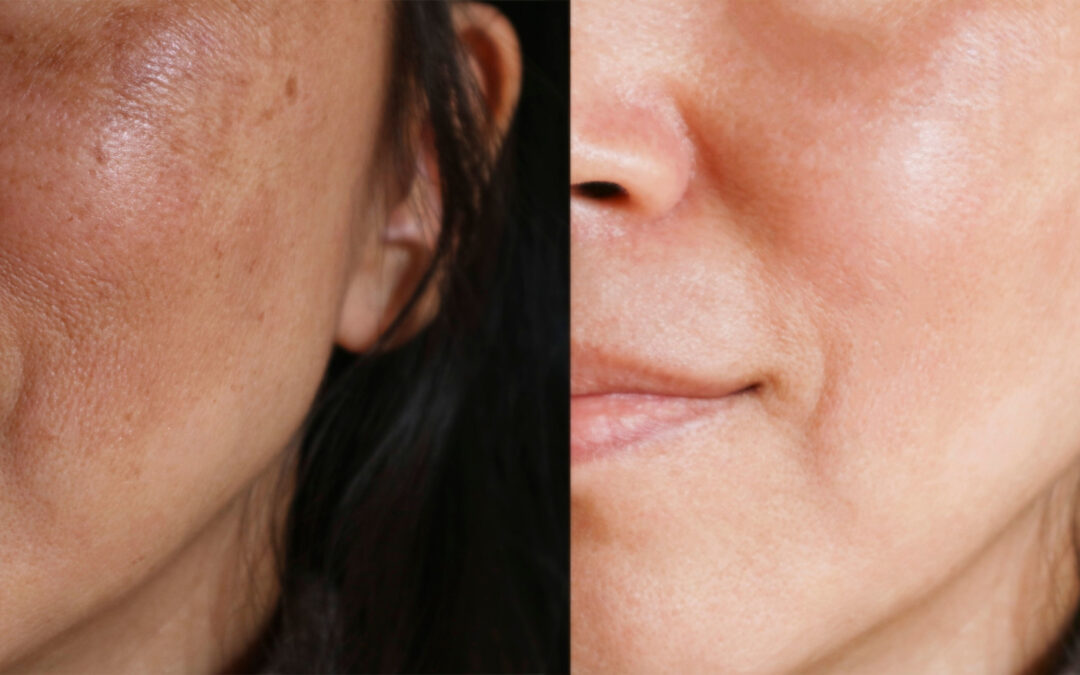Melasma is a relatively common skin problem that can cause a variety of discolorations and pigment changes in the skin. These include blue-gray or brown patches, or freckle-like spots. It happens when there is an overproduction of cells that create color in your skin. The patches, which are darker than your usual skin color, tend to be symmetrical on either side of your face. Other areas of the body, often ones prone to sun exposure, that experience melasma include your cheeks, forehead, nose bridge, chin, neck, and forearms. Melasma tends to be fairly chronic (3 months or more) but can last for short periods as well. It is not painful, itchy or uncomfortable.
The causes of melasma are still slightly mysterious, but there is more of a risk in darker-skinned people. Estrogen and progesterone sensitivity, and use of birth control pills by extension, can also have a role in creating breakouts of melasma. Hence, the coined term “mask of pregnancy” when hormone levels go through drastic fluctuations.
Stress and thyroid problems can be included in this category as well.
Certain irritating skin products and phototoxic drugs (medicines that create skin changes when exposed to sunlight) can be related to development of the condition.
The three types of melasma depend on the depth of the pigment.
- Epidermal: Epidermal melasma has a dark brown color, a clear border, appears obvious under black light, and sometimes responds well to treatment.
- Dermal: Dermal melasma has a light brown or bluish color, a blurry border, appears no differently under black light, and doesn’t respond well to treatment.
- Mixed melasma: Mixed melasma, which is the most common of the three, has both bluish and brown patches, shows a mixed pattern under black light, and shows some response to treatment.
The good news is that melasma is not linked to cancer, though there are skin cancers that mimic melasma — so it’s always better to have your medical professional take a look.
Though this condition is typically chronic, meaning it can last months to years, there is some hope as to the types of treatments out there and foods associated with decreasing the pigmentation by way of removing oxidative damage and reducing inflammation.
Certain antioxidants found in fruits and vegetables, such as vitamin C, E, and niacinamide are known to protect against UV rays the major culprit that causes melasma.
Some scientists have found a correlation between low folic acid levels, therefore checking your level with your provider, and if low, replenishing with a preferably, methylated folate will ensure adequate supply. Foods high in folate include nuts, green leafy vegetables, and whole grains. In addition, high levels of copper in one’s diet has been shown to cause excess melanin production and pigmentation. One way of ensuring that your copper levels are balanced is to take vitamin C and iron supplements.
Being that inflammation is one of the main root causes of melasma, an emerging technology called Glacial Rx is currently being explored by the FDA as a way of treating melasma.
The process uses CryoModulation™, which freezes melanocytes in order to stymy the generation of melanin in your skin. New epidermal cells grow and replace the previously pigmented surface cells. This leads to a more even skin tone, and over time dark spots will become lighter and less visible.
At Seaside, we have found that this system suppresses inflammation through its use of precise cold administration in conjunction with brightening agents, thereby creating a miliu of positive changes which in a way, “smartens” your skin. Our patients are seeing effective results after 3 treatments in breaking up the melasma patches, and the procedure is made for all skin types including darker skin tones or sensitive skin.
References:
https://clinicaltrials.gov/
https://navamd.com/face-
https://my.clevelandclinic.
https://www.health.harvard.

